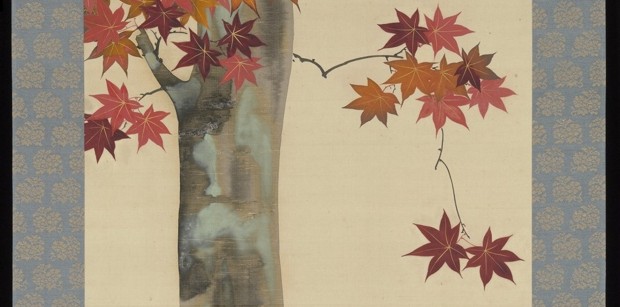An iconographic and text archive related to communication, technology and art.
☛ The Metropolitan Museum of Art: “Autumn Maple” by Sakai Ôho (1808–1841), hanging scroll, ink and color on silk, image is 45 1/2″ x 16 5/16″, Gitter-Yelen Collection.
Description from the MET’s website:
As is the case with many painting traditions, the Rinpa repertory of themes was maintained through the practice of copying the work of one’s predecessors. In Autumn Maple, Ôho reproduces a composition originated by Hon’ami Kôho (1601–1682), the grandson of the celebrated calligrapher Hon’ami Kôetsu. The image of an isolated maple tree with a long vertical trunk, thin branches, and luminous red leaves was developed by Kôho as the leftmost painting in a triptych, and was subsequently copied by Sakai Hôitsu, Ôho’s teacher. Ôho’s version has fewer leaves, which heightens the contrast between their sharply delineated red and orange forms and that of the velvety soft trunk—created through use of the mottled ink (tarashikomi) technique.
Sakai Ôho was one of Hôitsu’s most talented pupils, but he died at a relatively young age and left behind a small corpus of signed works. Adopted by Hôitsu when he was ten years old, Ôho also was allowed to take one of Hôitsu’s art names after his master’s death and thus became known as Uke’an II.
This painting is part of the Designing Nature. The Rinpa Aesthetic in Japanese Art exhibition (May 26, 2012–January 13, 2013). A detail worth noting: “Rinpa” is sometime spelled “Rimpa”. All 116 objects from this exhibition are viewable online in large, zoomable format.
The Japan Society (New York) is also having an exhibition featuring master if the Rinpa style: Silver Wind: The Arts of Sakai Hōitsu (1761-1828). Together with the MET, it is said to be one of the largest display of Rinpa style art to have taken place outside of Japan. There’s a very good review of both exhibition in The New York Times:
Although sometimes referred to as a movement, Rimpa was really a style or sensibility passed on, with breaks in the flow, throughout the Edo period (1615-1868) and into the 20th century. Although painting was its most conspicuous medium, Rimpa was about design, total effect, taste that embraced calligraphy, textiles, ceramics and lacquer. You painted Rimpa, but you also wrote it, wore it, and ate your sushi and drank your tea from it.
That said, the style is hard to define. Seasonal change in nature is its recurrent subject. But the Rimpa version of nature is often highly stylized, posed, poeticized, simultaneously abstracted into ornamental patterns and rendered with fantastically detailed accuracy. (“Boldest Color for Total Effect. Rimpa Painters at Japan Society and the Met” by Holland Cotter, Sept. 27, 2012).
Below are detailed views from Sakai Ôho’s painting: click the images for a larger format or head over to the MET’s website where the painting is zoomable.




